Trigger Warning: Graphic and Bloody Content Related to Medical Treatment
Also, there is a link to my podcast, equally scary.
I call the following picture “Why I Can’t Have Nice Things…” Continue reading Inability To Write
Trigger Warning: Graphic and Bloody Content Related to Medical Treatment
Also, there is a link to my podcast, equally scary.
I call the following picture “Why I Can’t Have Nice Things…” Continue reading Inability To Write
By chance, cleaning through my unread emails, I stumbled across notes and pictures for a post I had planned for nearly a year ago and for some reason never published. It struck me that it could very nearly have been something I wrote just this week. There wasn’t much written, just two rough paragraphs, but it did come with a nice collection of pictures. Here is what would have been, from November 4th, 2017:
There’s no doubt that dealing with the side effects of cancer treatment can be perplexing. Patients deal with everything from digestive issues to pain to total hair loss to fatigue to stiff joints.
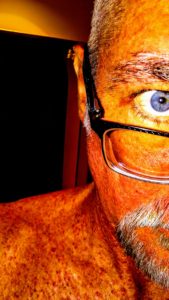 I was told twice in one day this week that I looked “bright.” I was smiling and active, keeping myself busy and directed, and I was surrounded by people who I had not seen in several months (along with a few I had never seen at all). It was the good nature of reconnecting in a friendly crowd without the threat of being lost in it, I imagine, that sparked my particularly good mood on that occasion. The description was used again on subsequent days by unrelated people, causing me to take note that, perhaps, the whites of my eyes have simply become whiter. (Insert your own Revolutionary War joke here.) Continue reading To Clear or Not to Clear
I was told twice in one day this week that I looked “bright.” I was smiling and active, keeping myself busy and directed, and I was surrounded by people who I had not seen in several months (along with a few I had never seen at all). It was the good nature of reconnecting in a friendly crowd without the threat of being lost in it, I imagine, that sparked my particularly good mood on that occasion. The description was used again on subsequent days by unrelated people, causing me to take note that, perhaps, the whites of my eyes have simply become whiter. (Insert your own Revolutionary War joke here.) Continue reading To Clear or Not to Clear
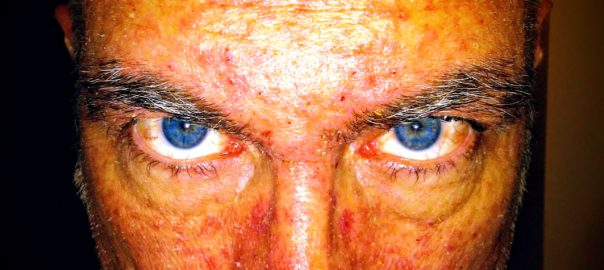
I spent well over 45 minutes combing scabs out of my sparse hair to commemorate the end of the second week of my third month on poziotinib. Not all at once, mind you; I had the good sense not to stand hunched over the sink for more than 20 minutes at a stretch. When I was done, or at least thought I should be, I rewarded myself by sort of washing and conditioning the wiry bristles that cover much of my scalp. Such are these minor celebrations. Continue reading Poziotinib and Me at Month Three: Feeling Crusty (But Still Onboard)
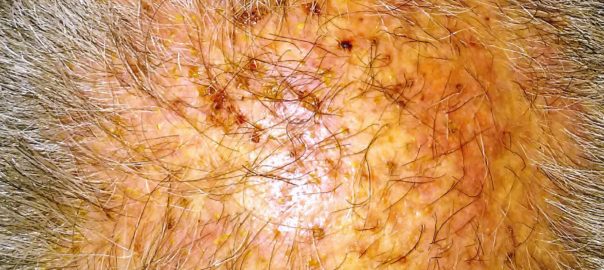
I am now into the third month of my clinical trial for poziotinib. After the first two months, I had to take two weeks off for recovery from the rash it gave me. I am, however, glad to be back on the drug for the very simple reason that it was effectively killing the cancer within me. That is not a claim I make lightly, or, sadly, have had reason to make much at all over the past year.
When I was first put on chemotherapy back at the end of 2014, it was because there were no targeted therapies or immunotherapies available, either on the market or through clinical trials, that were likely to work for me. Chemo seemed to be the only option and, in some ways, it felt like a last-ditch effort. My tumor was considered inoperable, the metastasis had spread too far and wide, and radiation was not even being presented as an option.
While I was primed for a limited response and the possibility that I might only get a few months extension from the process, it turned out that chemo kind of worked for me. It worked well enough, in fact, that I would stay on it for over two and a half years — most of that time, simply keeping the cancer growth in stasis. There was talk of the possibility of being on that drug for five or more years at one point, but not long after the two-year mark I began to notice small changes in my scans. Very small, but changes, nonetheless. Continue reading Week One: The Oozing Begins
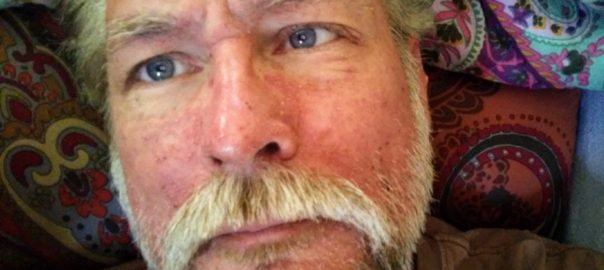
Crouched over the kitchen sink, I surged with a repressed groan, stifling the convulsive impulse as tears broke free; I cried, uncontained, momentarily unaware why. I was so used to keeping it in, I had become disconnected from what I was actually feeling — ironic, because what I was feeling right then was disconnected.
I did not recognize my body. This vessel in which I was contained made no sense to me at all. It responded to my thoughts and commands, but it felt completely foreign. Looking down at my arms, my hands, my fingers, I recognized nothing. They could hold the dishes I was washing, turn the knob on the faucet, even scrub with the brush. But there was a clumsiness about them, an awkwardness that was hard to explain or rationalize, except to know immediately that none of that was part of my body. None of it was Me.
Such is the effect of bodily changes that occur under cancer treatment. I was experiencing a slight case of dysmorphia, that feeling of certainty that you are not in the right body. It passed, but the emotional impact lingered. Continue reading This Is Not My Body
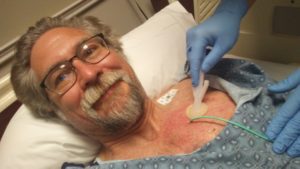
At the end of May, I began participating in a clinical trial for Poziotinib, a new targeted therapy that works on mutations in the EGFR and HER categories. Naturally, within days of my May 23rd start, I had already begun exhibiting side-effects from the new medication. The resulting rash has persisted and spread, morphing into a completely new experience for me. I thought at the time that the minor ordeal I had in preparing for the clinical trial would have been the biggest challenge of the trial itself: first I went in for a “simple” needle biopsy procedure, then I had to stay to deal with the effects when things did not go exactly according to plan. The experience even inspired an opinion piece for the Philadelphia Inquirer. But I passed over that (still relatively minor) road bump and ran headlong into the clinical trial and resulting crash back into Rashville.
Having a rash does not sound all that bad in the grand scope of things. A little salve, a dollop of willpower, and it should be easy to weather. Itching too much? Slip on some gloves or spray it with lidocaine. Rashes pass. At least it is not nausea or debilitating pain or sleeplessness. Well, at least it is not nausea. Continue reading Endurance and Payoff
Spoiler alert: my rash has returned.
Before I get into the details of this new leg of my journey, I’m taking a moment to reflect on the side-effects of the past. In August of last year (2017), I stopped taking chemotherapy due to signs of progression. After about a month of cleaning out my system, I noticed a serious boost in both my mental and physical energy levels. My body began shaping up. I felt really good. And I started my first “targeted” therapy, the drug Gilotrif (generic name, afatinib).
Gilotrif was highly promising at the time. It had shown some level of effectiveness on the HER2 mutation in cancer studies but was still off-label for my use because it was designed to target a very closely related mutation. I loved it at first, however, because I kept feeling better and — in comparison to my 2 years and 8 months on Alimta (generic name, pemetrexed) — there was just an amazing lack of initial side-effects. Alimta had been fairly easy to tolerate overall and I had no real complaints considering how well it had worked. But I did have some skin and digestive issues, as well as persistent fatigue, that plagued me every month. Toward the end, the skin issues were particularly bothersome, and I was beyond thrilled when they cleared up. Continue reading The Rash Is Back
It has been over two weeks since I began taking my new drug, afatinib. Over two weeks of feeling good, feeling like the chemo has been thoroughly flushed from my system even as I have diligently taken these new pills, feeling the best that I have in three years. I have been keeping a journal this time, chronicling how my body is responding each day, trying to pave the way for a better understanding of how to live with this new treatment. For the first week, anyway, it almost seemed like it was going to be too easy.
There are two weeks of video updates on my Patreon feed, talking about how great I feel and wondering how bad the side effects will be once they really kick in. I had been prepped by my oncologist that it was very likely that I would experience worse side effects than I had with the chemo I had been taking. This was based on how well I tolerated pemetrexed, the chemotherapy drug that had kept my cancer at bay for so long, but not so much on patients in general having a particularly tough time on afatinib. Which is not to suggest that I expected a walk in the proverbial park with this new drug.
Still, the first week was amazing. It was almost like I was taking nothing at all. Sure, there was some digestive stuff going on, but nothing outside of the realm of what I would have been used to in a previous life if I decided to live off of bean burritos for a few weeks. And I love a good burrito, so it would be worth it. But by day eight, I realized that the side-effects of the drug were presenting themselves quite visibly. Continue reading Spoiler Alert: Side-Effects Show Up
I knew that I would not stay on chemotherapy forever. So getting to the point where I ended my “chemo journey” was not completely surprising. In fact, I had anticipated that a change would be good for some time — after over 2 1/2 years of the same routine, not only had it begun to gnaw at me each time I faced another infusion and ensuing side effects, but there was something of a “gut feeling” that the chemotherapy drug I had been on for so long had done about all it could do. I was probably influenced a lot by the promise of Immunotherapy drugs that had become the media darlings of the cancer world. When my oncologist said it was a good time to consider another approach, I was eager to do it.
Besides immunotherapy, for which I had hoped to join a clinical trial, there was the possibility that I might harbor an actionable gene mutation for my adenocarcinoma. My initial genetic analysis from a biopsy prior to starting chemo had shown none of the mutations that were being directly treated at that time. But a couple of years makes a big difference in the cancer world, especially with the increasing rate of progress science has been making over the past few decades. A re-analysis of that old biopsy showed nothing new, but a quick, painless liquid biopsy — two simple tubes of blood and fifteen minutes of my time — revealed that I harbor a fairly rare mutation, one that affects roughly two percent of the adenocarcinoma subset of lung cancer patients: ErbB2, also known as HER2.
This shifted gears for me regarding the drive down my treatment path. It also made me shift perspective. There is the question, now, of whether finding myself in such a cancer minority is a sign of good fortune. On one hand, it means that my genetic demographic is not highly studied — the downside to minority group patients is simply that there are fewer of us to put into clinical trials. Flip that over, however, and it makes the trials that have been done highly specific — and it makes the case studies on patients with this mutation also highly specific. Which in turn suggests that this might be a very positive development after all. Continue reading Frying Pan, Meet Fire – Leaping from One Therapy to Another